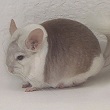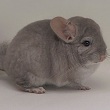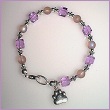Chinchillas.com Newsletter
Volume 3,
Number 2 - October
28, 2005
Auction Update
This week on the auction, Chinchillas.com is offering a most unique beige and white hybrid, along with two special promotional auctions.
| 5218 is a truly unique extreme mosaic. He is sired by a pink white male with a body spot, and out of a top standard female. Additionally, he is a show quality male with very good color and fur quality. A high quality hybrid chinchilla of this phenotype is only produced once in a very rare while. | |
| 5132 is a Tower Beige male with excellent color and fur quality. He would be an very good sire for producing quality beige and pink whites. He is missing an ear due to an accident as a young chinchilla, but this will not affect his showability in the US show systems, or his ability to produce quality offspring. He is being offered with no reserve. This is an excellent opportunity to obtain a high quality beige male for your breeding program. | |
| Chinchillas.com is also offering a Lavender Swarovski Crystal, Frosted Glass, and Sterling Silver Chinchilla Paw Charm Bracelet. The bracelet is made with all sterling silver fittings and clasps, and Swarovski crystal imported from Austria. There is no reserve on this item. |
Producing Extreme Mosaics
It is an unpredictable and sometimes difficult job to produce extreme mosaics. A basic understanding of the white gene is important, because it is this gene that allows for the interesting coat patterns to appear in the phenotype. In chinchilla lanigera, there is no piebald gene equivalent to the dominant Tobiano or recessive Overo gene that we see in paint horses, nor is there a true spotting gene like that which occurs in the spotted Appaloosa horse. The incomplete heterozygous-only dominant white gene in chinchillas sometimes gives the illusion that it is a spotting gene, but that is only because it is an incomplete dominant, not a complete dominant gene. This means that the gene does not successfully cover up the other color genes in the genotype, therefore allowing the grey, or beige, or whatever other colors are present to 'show through.' An easy way to picture this is to imagine that the white gene is like a blanket with holes in it, and some white blankets have more holes than others. It is because of the inconsistent transmission of the white gene that we get animals all with the same color genotype, but with distinctly different phenotypes resulting in silvers, mosaics, predominantly whites, and occasionally extreme mosaics. It is assumed that there are other genes which account for variations in color coat patterns that come into play when an extreme mosaic is produced. The sire of 5218, for example, was far from the extremely marked 5218, but he did have a distinct body spot. Since we cannot see the genes that contribute to interesting color coat patterns on non-white animals, we can only trace their possible existence by keeping notes in the pedigrees. By using high quality chinchillas with spotting evident in the background, our incidence of producing extreme mosaics may be increased. Interestingly, some of the most extreme mosaics we have encountered were sired by white or pink white sires, and out of dark standard dams, as was the case with 5218.
Chinchillas.com | 1265 160th Rd | Seneca | Kansas | 66538
Notice:
Your personal preferences are set to receive newsletters
and surveys from chinchillas.com. To modify your personal preferences
and unsubscribe, go to http://www.chinchillas.com/personal
and log in to your personal account, select View/edit your personal information
then change "participate in survey" to no and "on mailing
list" to no.
Copyright© 2004 Chinchillas.com All rights reserved. Designated trademarks and brands are the property of their respective owners.



